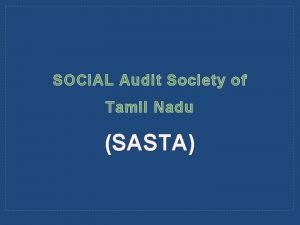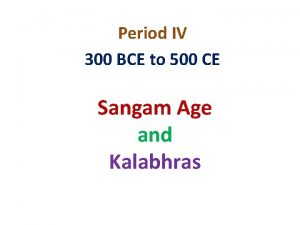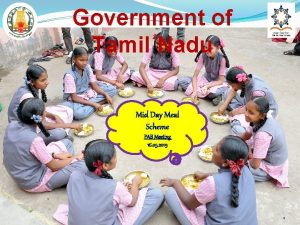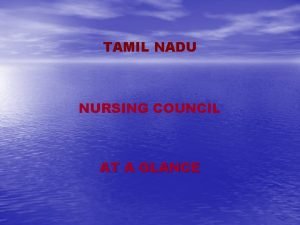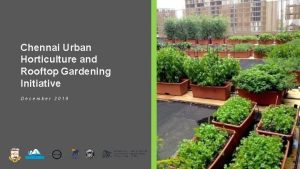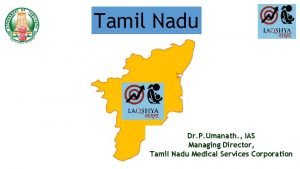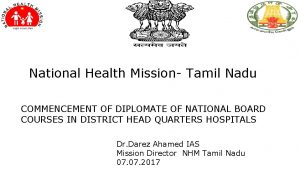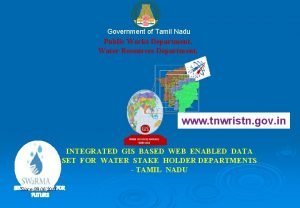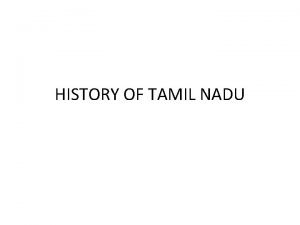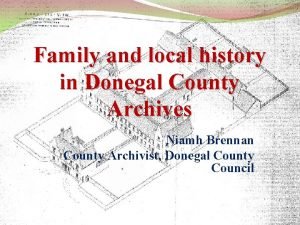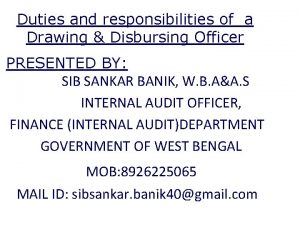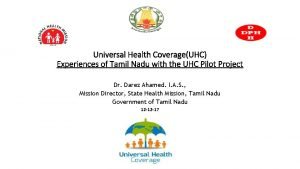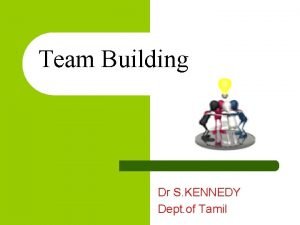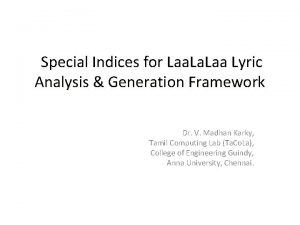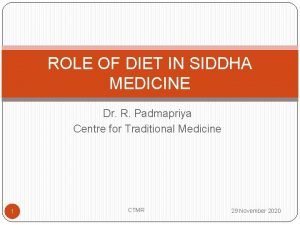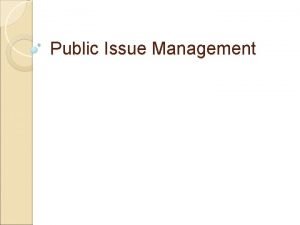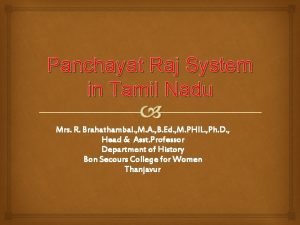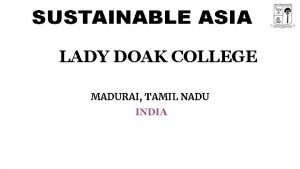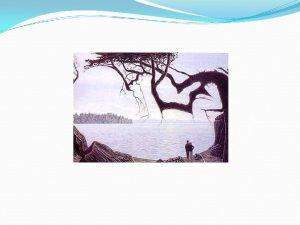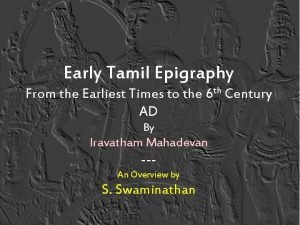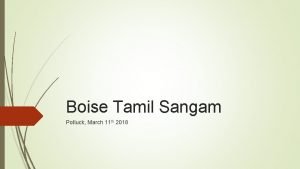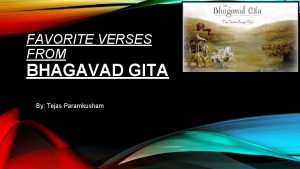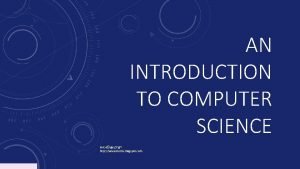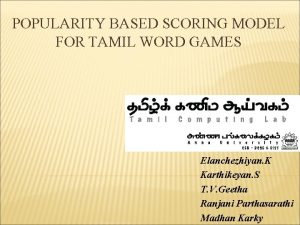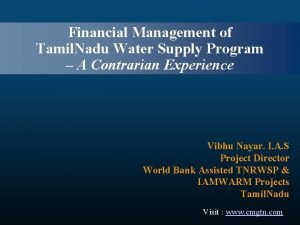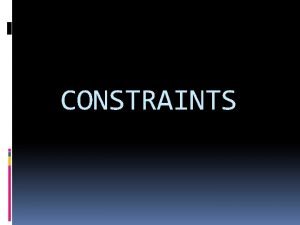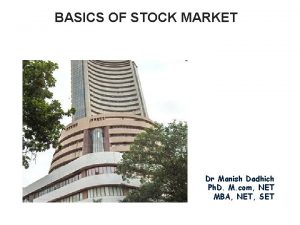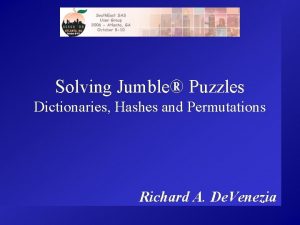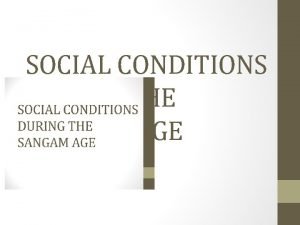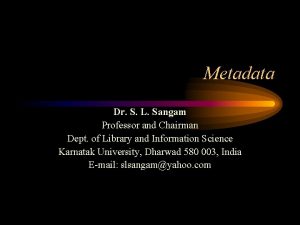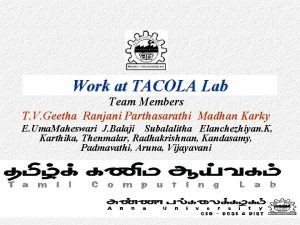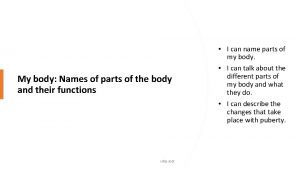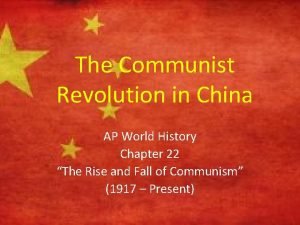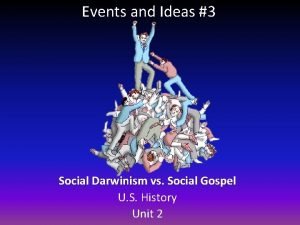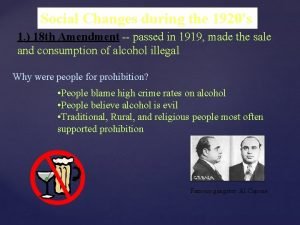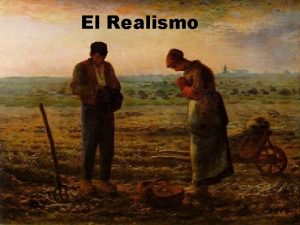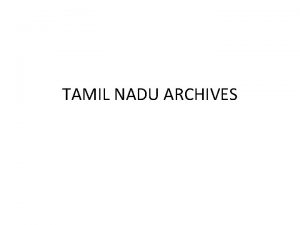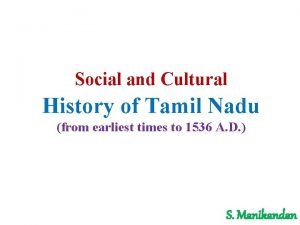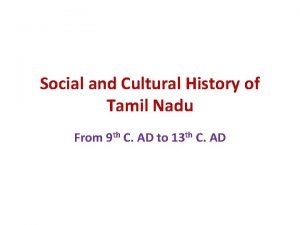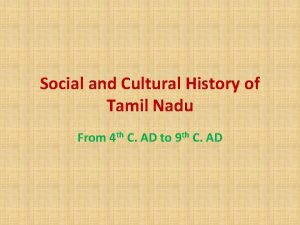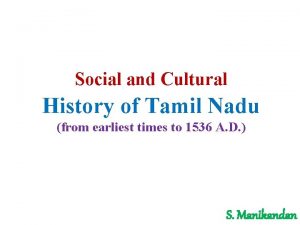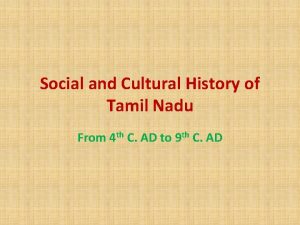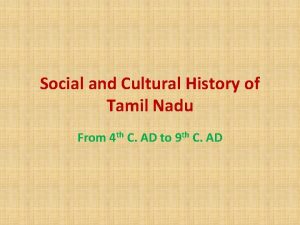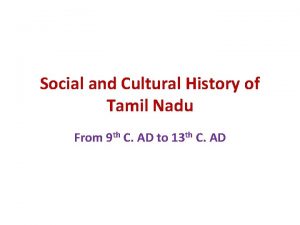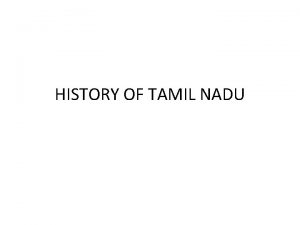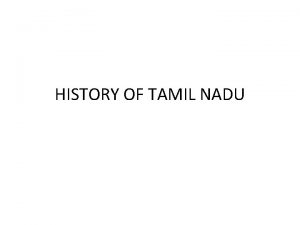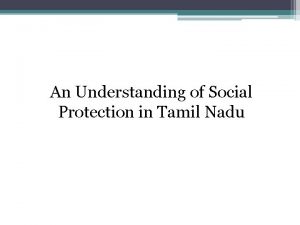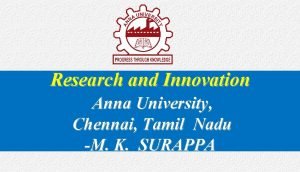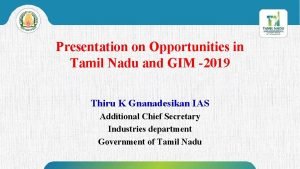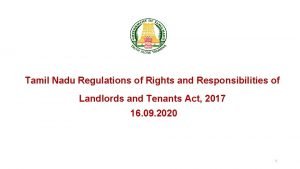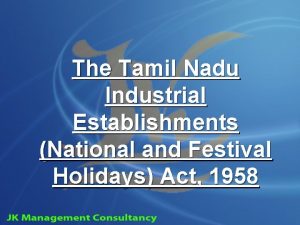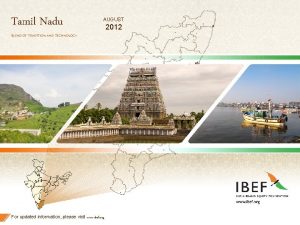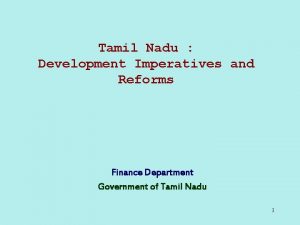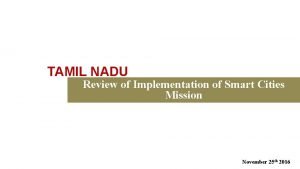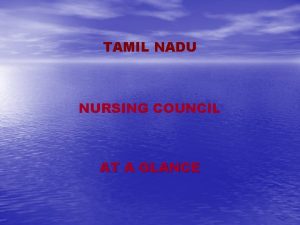Social and Cultural History of Tamil Nadu From















































- Slides: 47

Social and Cultural History of Tamil Nadu From 13 th C. AD to 16 th C. AD

Social Life in Pandyan Empire • The society under the Pandyas was based on the traditional fourfold division, namely the Brahmins, Kshatryas, Vaisyas and Sudras. • There were also other communities based on their vocation like Vellala, Ayar, Idaiyar, etc. However, the caste system was not rigid. • Generally, people were respected not on the basis of caste but on the basis of their occupation. • Despite caste divisions and political chaos during the Pandyan rule, there was a sense of unity among the people. • We come to know that the village assemblies carried on many public activities smoothly.

Dress and Ornaments • The people wore clothes made of silk and cotton. • The rich were fond of silk garments. • Ordinary people wore cotton clothes. • The rich people were also fond of decorating themselves by various jewels and ornaments. • The kings and nobles wore costly ornaments studded with pearls, corals and precious stones.

Status of Women • In the Pandyan kingdom, women were generally treated on a par with men. • They took part in public functions along with man. • They were allowed to possess property. • The women from royal families got more opportunity to educate themselves. • The famous Vaishnavaite Alwar, Andal had lived in the Pandyan Empire and attained glory during this period. • Generally, the married women had concentrated more on the upkeep of their house and their children. • They also followed vocations like spinning, pot making, painting, etc. and raised their family income. • They had also extended help to the men-folk in agricultural activities. Women spent their leisure in playing in-door games like dice, chess, etc.

Education • The Pandyan rulers had evinced special interest to improve education. They had patronized poets and scholars. • The temples and Mutts had served as important educational centers. Land other grants were given to promote education and literature. • The Mutts established at Tirunelveli, Seranmadevi, Alagarkoil and Vanamamalai had contributed to the growth of education. • Both the Tamil and Sanskrit language and literature were taught in these Mutts. • The Pandyan kings had patronized both the Sanskrit and Tamil languages. • Institutions of higher learning were called as Salais. • Subjects like Vedas, Grammar, Politics and Law were taught and students from noble families got their education from these institutions.

Language and Literature • The Pandyan Kings had evinced much interest in the Tamil language. • Their capital Madurai continued to remain the centre of Tamil literature. • It was called as Tamil Kudal. • The Vaishnavaite saints namely, Nammaazhwar, Periyaazhwar and Andal had composed beautiful Tamil verses in praise of Lord Vishnu. • The Saivaite saint, Manickavasagar had also composed his verses in Tamil. He was the author of Thiruvasagam.

Saivite Literature • According to the information’s given by a foreign writer Hiuen Tsang and Velvikudi plates, the Pandya kings worked for the development of literature, art and architecture. • Particularly they contributed more for the development of Saivite literature. Thirugnanasambandar influenced his contemporary Pandya king Maravarman Arikesari. • Saint Manikavasagar composed the divine hymn Thiruvasagam. He also wrote Thiruchirrambalakovai. • The saiva nayanmars were more respected. Saivism flourished with their patronage.

Vaishnavite literature • The Pandya kings patronized Aiwars and vaishnavite literature, Periyazhvar and his daughter Andal contributed greatly for the progress of Vaishnavism. • Andal composed the famous Thiruppavai. Nammalvar composed Thiruppallandu. • These two vaishavite literary works of the Pandya period are given very high position in the Indian religion and literature. • The Pandya literatures like Thiruppavai and Thiruppallandu have enriched the Indian religion and literature.

Cont… • The Pandya king Adhiveerarama Pandya of Thenkasi wrote Naidadham. • Sri Kaviraya wrote four books namely Thirukkalathinatharula, Thiruvannamalaiyar vannam, Seyur Murugan ula, Rathinagiriula. • King Varathungarama Pandya wrote three books namely pathitrupathu, Kalithurai andhathi and Venba andhathi. • Mayilai nathar wrote commentary on Nannool. • Adiyarkkunallur wrote commentary on Silappathiharam. • Senavrayar wrote commentary on Tholkappiyam. • Parimelazhagar wrote commentaries on Thiurkkural.

Religion under the Pandya Empire • After the decline of the Kalabhra rule, Hinduism was once again revived and Buddhism and Jainism began to decline. • The Pandyan kings had patronized Vaishnavism, Saivism and Jainism. • The Nayanmars had preached Saivism while the Alwars preached Vaishnavism. • They had spread the spirit of Bakthi among the people. The spread of Bakthi cult inculcated religious feelings and service mindedness among the people. These qualities had taken deep roots in the Tamil society.

Cont… • The Saivaite Saints, namely Thirugnanasambandar and Manickavasagar had lived in the Pandya country and propagated Saivism. • Similarly the Vaishnavaite Saints, Nammalwar, Perialwar and Andal had preached Vaishnavism in the Pandyan kingdom. • The Pandya kings generally followed religious tolerance. • They had made liberal donations and gifts to the Jain monks and to their educational institutions.

Art and Architecture • The Pandyas contributed more for the development of architecture. • Gopuras, Prakaras, Vimanas, Garbagrahas are the special features of the Pandya temple architecture. • Temples at Madurai, Rameshwaram, Tiruchendur, Chidambaram, Kumbakonam, Thiruvannamalai, Srirangam, etc. , are good examples for the development of Pandya architecture. • The images of horses and other animals are carved on pillars. • According to historian A. L. Basham, The zenith of Pandya architecture are Meenakshi temple at Madurai and Aranganathar temple at Srirangam.

Madurai Meenakshi Amman Temple

Rock cut Temple • The Pandya period is marked as renaissance period in the field of rock cut temple. • The rock cut temples are known for their merit. • More than 50 rock cut temples were excavated from the Pandya kingdom. • More rock cut temples are found in Thirupparankundram, Anaimalai, Karaikudi, Kalugumalai, Malaiyadikurichi, Chithannavasal and Trichy. • These temples were constructed for Lord Siva and Vishnu. Cave temples are also found in temples at Kalugumalai and Trichy. Rock cut caves were also there.

Vetuvan Koil, Kazhugumalai

Thiruparankundram

Yanaimalai

Yanaimalai

Ladan koil in Yanaimalai, Madurai

Structural temples • The second Pandya kings also promoted structural temples. Structural temples were built on stones. They were simple in style. • Each temple consists of Garbagraha, Arthamandapa and Mahamandapa. • Such structural stone temples are found in Kovilpatti, Thiruppathur and Madurai. • The Pandya kings constructed structural temples at Ambasamuthram, Thiruppathur. Mannarkudi, Madurai, Alagarkoil, Rameshwaram, Tiruchendur, Tirunelveli, Kanyakumari, etc. • In Srivilliputhur and Chinnmanur, Internal structures of these temples were constructed in a planned manner.

Cont… • The Vadapadrasayi temple at Srivilliputhur, Siva temple at Ambasamudhram, Vijayanarayana temple at Nanguneri and Lakshmi narayana temple at Athur are some of the famous structural temples. • Pandya rulers built big gopurams at the entrance of the temples. • Pandyas built temples mandapas, gopurams at Chidambaram and Srirangam. • Kulasekara Pandya built arthamandapa. manimandapa and sannathi in every temple, Sundara Pandya and Sadaiyavarman built gopurams during their period. • Pandya rulers renovated Alagarkoil and Jambukeswara temples.


Tenkasi

Jampukeshwara temple, Tiruvanaikkaval

Nellaiyappar Temple, Tirunelveli


Rameshwaram

Udprakaram (Inner view), Rameshwaram

Sculpture • Pandya period witnessed renaissance in the art of sculpture. • Pandyan sculptures are beautiful and ornamental. • Some sculptures are engraved on single stone. • They have got more messages and values. • Sculptures of Somaskandar, Durgai, Ganapathy, Narasimha, Nataraja are very good specimens. • Sculptures at Kalugumalai, Thirupparankundram, and Thiurmalaipuram are very famous. • Vishnu sculpture at Kunnakudi and Nataraja sculpture at Thiurkolakkudi are on par excellence with the sculptures of Pallava, Chola period.

Paintings • The beauty of the Pandya mural painting can be seen in the Chittannavasal cave temples constructed during the time of Srimaran and Srivallaba Pandyan. • The ceilings and pillars at Chittannavasal bear the paintings of dancing girls, the kings, the queens, plants and animals. • The picture of lotus, bathing elephants and playing fishes were good at Chittannavasal. • Oil painting was also there. They are outstanding examples of Pandya paintings. • Pandya rulers contributed more for the development of literature, art and architecture. • The paintings of Chittannavasal are compared with those found at Ajantha caves. • Their contributions created a unique and permanent cultural impact upon the Tamil society.

Society under the Vijayanagar Empire

Social Condition • People with various cultures and languages lived together happily. • Caste system was there. • Royal family members and nobles led a luxurious life. • Common people led poor life.

Social Divisions • Vijayanagar society was divided into many divisions. Brahmins and Vellalas were dominant groups. • Sourashtras of Gujarat who came and settled in Tamil Nadu had supplied clothes to the royal house and nobles. • The Reddies and other agriculturists migrated to Tamil Nadu during the Vijayanagar rule. • The Portuguese, the French, the Dutch, the English and the Arab Muslims settled here. • These foreigners had their own churches and mosques. • They had mixed response from the native population.

Cont… • Indian Muslims, Christians formed another section, Goldsmiths, blacksmiths, carpenters, and weavers formed sizable group in the society. • Fishermen who lived in the east coast were converted into Christianity. • Valangai and Idangai groups had frequent conflicts among themselves. • Some times they joined together on certain issues.

Condition of Women • Women were respected more. Some women participated in Public life. • Some of them were appointed in both civil and military departments. • Some women were talented in music, dance and poetry writing. • Marriages had sacred and social importance. Dowry system was there. • Horse riding, hunting, chess, boating, kolattam, kummy were the favorite games in the society. • Krishna devaraya’s daughter was a very good chess player. The Telugu, Kannada speaking people migrated in to Tamil Nadu. • Music and dance were encouraged.

Food and Dress • Rice and millet were their main food. • The habit of chewing the betel leaf was also there. • Free meals were provided in the choultries. • Generally people wore cotton wool and line dresses. • The nobles wore embroider dresses with golden threads, Rich people wore shoes and poor people remained bare footed. • Women had the practice of wearing costly gold ornaments with precious stones and pearls.

Education • During the Vijayanagar rule education was confined only to certain sections of the Society. • Gurukula education was there. Classes were conducted both in teacher’s houses and temple premises. • These educational institutions had royal support. • Vedas, astrology, subjects like medicine were taught.

Literature • Vijayanagar kings patronized Tamil, Telugu and Sanskrit scholars, poets and philosophers. • Krishna Devaraya composed Amuktamalayada, which is considered as one of the five Telugu kaviyas. • There were eight scholars in the court of Krishnadevarya. • They were known as Ashtadiggajas. • Krishnadevaraya stopped the practice of translating from Sanskrit to other languages. • He encouraged original thinking and writing in the field of literature.

Cont… • Krishna Devaraya marked a new beginning in the literary history of South India. • The influence of Vaishnavism was found in the Telugu and Tamil literature. • Gangadevi wrote Maduravijayam which is an important literary evidence about her husband Kumarakampana’ s conquest of Tamil country. • Allasanipeddanna, Nanditimmanna Tenaliramakrishna were leading Telugu scholars. • Telugu literature flourished well.

Tamil Literature • Vijayanagar period marked good development in Tamil literature. Tamil Scholars of Saivism, Vaishnavism and Jainism were encouraged. • Meykandar wrote Sivagnana Bodham. Velliyambala Tambiran wrote Gnanapuranavilakkam, Alagiyadesikar’s Sethupuranam, Kachiappassivachariar’ s Kandapuranam were important Tamil literary works. • Villiputhurar translated Viyasar’s Bharatam in Tamil.

Cont… • Chidambarapuranam and Chokkanatharula were written by Thirumalainathar. • Haridasars wrote lrusamaya vilakkam. • Nalavenba, is famous Tamil work of that period. • Commentaries were written on Tholkappiayam and Silappathiharam and also on many vaishnavite religious texts. • Nallurveerakavirayar’s Harichandrapuranam and saint Pavanandhi’s Nanool were important works written during Vijayanagar period.

Religious Condition Under the Vijayanagar Empire • The Vijayanagar rulers encouraged all religious faiths. Their most favorable religion was Hinduism. • Many areas of Tamilnadu were relieved from Muslim sultan’s rule and were placed under the Vijaya nagar Hindu rulers. • Temples of Madurai, Srirangam. Thiruvarur, Rameswaram, Chidambaram, Tirunelveil, Thiruvannamali and Sirvilliputhur were repaired and rebuilt. • Some of them were enlarged with an additional gopurams, praharas, entrance towers, corridors and mandapas. • New temples were built in Kanchipuram, Kumbakonam and Vellore. • Sculptures were carved on pillars. Maharasankaranihi, Mahanavami, Ugadi, Deepavali, karthigai and holi were celebrated. • Coins issued by Vijayanagar kings proclaim their conviction towards Vaishnavism.

Cont… • King Achyutaraya made liberal grants to the Varadaraja and Ekmahareswarar temple at Kanchi. • He built the image of Lord Thillai Govindaraja at Chidambaram. • Jain temples were built. Muslim dargas were respected. Christian missionaries were functioning in Tuticorin, Vellore and other areas. • The early Vijayanagar kings were saivites and the later kings were vaishnavites. So both saivism and vaishnavism flourished during this period. • This reflected in Tamil country also. Vadaglai and Thengalai: Vadagalai and thengalai groups were there among the vaishnavites. • The Vadagalai group was led by Vedhanta Desikar. They followed Sanskrit vedas. • Thengalai group was led by Manavala Mahamuni. Thengalai group followed Tamil Prabandhams. • Vadagalai people believed in caste system but Thengalai people did not believe in caste system.

Art and Architecture • During the period of Vijyanagar rulers the Tamil country faced an introduction of new style in the field of art and architecture. • Two different styles of architecture namely the Dravidian and Indo-Saracenic architecture were famous during this period. • The two gopurams (tall tower) of Rameswaram temple and Seshagiri mandapam at Srirangam ‘are the best examples Vijayanagar art. • Vijayanagar king built a famous temple inside the Vellore fort. Special feature of the Vellore temple is the Kalyana mandapam attached to that temple. This is one of the best examples of the Dravidian architecture style of Vijayanagar kings.

Cont… • The palace of Madurai built during this period is a good example of Indo Saracenic architecture style. • Krishna Devaraya built a good part of a northern tower of Chidambaram. • He also constructed the south side of Ekambaranatha shrine at Kanchipuram. • He built pudumandapam and many temple towers at Madurai and Thiurvannamalai.

Cont… • New temples were built in Vellore, Kumbakonam, Srirangam and Kanchipuram. • Gopurams towers, forts and palaces constructed during this period are famous even today. • The last stage of the Vijaya Nagar architecture was known as Madura style. • The art of casting bronzes was famous. Some of the Vijayanagar paintings of God, Goddesses, purana story pictures and images of kings are familiar even today.

Chidambaram Natarajar temple
 Mgnrega social audit tamilnadu
Mgnrega social audit tamilnadu Sri lanka tamil population
Sri lanka tamil population Time bound promotion for doctors in tamilnadu
Time bound promotion for doctors in tamilnadu Noon meal forms 2020-21
Noon meal forms 2020-21 Introduction of tamil nadu
Introduction of tamil nadu Tamil nadu horticulture terrace garden kit
Tamil nadu horticulture terrace garden kit Tamil nadu cm special cell
Tamil nadu cm special cell Dr umanath ias
Dr umanath ias Nhm tamilnadu
Nhm tamilnadu Public works department meaning in tamil
Public works department meaning in tamil Cheran senguttuvan brother
Cheran senguttuvan brother Nadu donegal
Nadu donegal Associated drawing & disbursing office(ddo)
Associated drawing & disbursing office(ddo) Dream big and dare to fail meaning in malayalam
Dream big and dare to fail meaning in malayalam Apa itu social thinking
Apa itu social thinking Social thinking social influence social relations
Social thinking social influence social relations History grade 9 unit 5
History grade 9 unit 5 Universal health coverage in tamil
Universal health coverage in tamil For women
For women Tamil kuril letters
Tamil kuril letters Thuringi manapagu
Thuringi manapagu Explain the mechanics of public issue management
Explain the mechanics of public issue management J v k rao committee
J v k rao committee Love all serve all help ever hurt never
Love all serve all help ever hurt never Doak meaning in tamil
Doak meaning in tamil Silver plus medicine
Silver plus medicine Group discussion in tamil
Group discussion in tamil Oldest tamil inscription
Oldest tamil inscription யச
யச Ciri ciri persamaan sekolah vernakular
Ciri ciri persamaan sekolah vernakular Gurureva gatir
Gurureva gatir Http //kalviamuthu.blogspot.com
Http //kalviamuthu.blogspot.com Elanchezhiyan meaning in tamil
Elanchezhiyan meaning in tamil Financial management in tamil
Financial management in tamil Example of scleronomic and rheonomic constraints
Example of scleronomic and rheonomic constraints Lame duck speculator
Lame duck speculator California tamil academy books
California tamil academy books Solve jumbled letters in tamil
Solve jumbled letters in tamil Social condition of sangam age
Social condition of sangam age Delhivery customer care number indore
Delhivery customer care number indore Sangam mulmi
Sangam mulmi Thirukkural search engine
Thirukkural search engine Body parts name female
Body parts name female Smart grid meaning in tamil
Smart grid meaning in tamil Collectivization ap world history
Collectivization ap world history Compare and contrast social darwinism and social gospel
Compare and contrast social darwinism and social gospel Social changes in the 1920s
Social changes in the 1920s Realismo contexto
Realismo contexto
